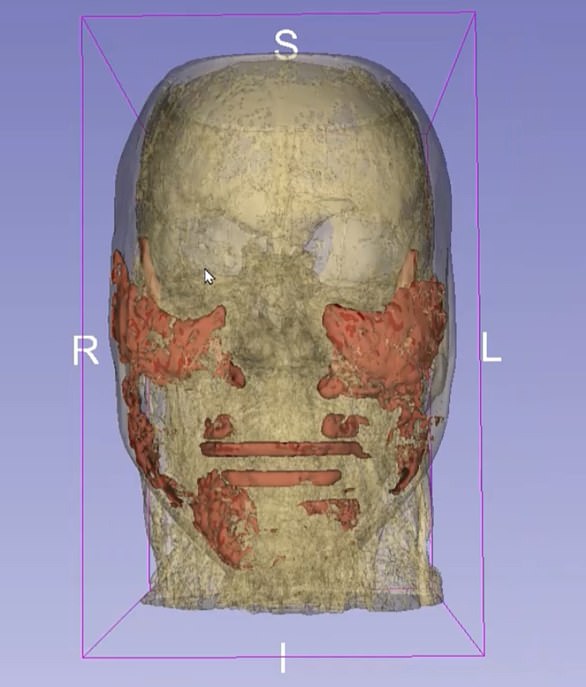Shocking rise of women in their 30s needing facelift surgery – because their looks have been ruined by fillers and Botox
Ashley Stobart was 18 when she ordered lip fillers for the first time. For more than ten years, she received regular injections in almost every part of her face. The shots—medical-grade gels that are injected and sit under the skin—add volume, creating a plump, pillowy pout and defined cheekbones.
Once the preserve of middle-aged women looking for an anti-aging solution, the number of teens and 20-somethings choosing it has skyrocketed. A survey of 18 to 24 year olds found that seven percent had a cosmetic lip enhancement, while 68 percent knew someone who had.
Why? Many speculate that the trend is driven by reality TV stars and celebrities who increasingly admit to or appear to have undergone cosmetic procedures.
Ashley has a simpler explanation for her decision: “Vanity,” she says bluntly.
When her family questioned her choice, she shrugged. “They would say, ‘Why do you have these big lips and big cheeks?’ I would think they were trying to tear me down – now I realize they were right. I no longer looked like myself.
‘But fillers are addictive. You don’t realize you’re starting to look a little funny.’
34-year-old Ashley Stobart, who was left with loose, uneven skin after more than a decade of using fillers, underwent a surgical face and neck lift
Ultimately, she admits, she didn’t recognize the person she saw in the mirror. So in March, now 34 years old and a mother of three, Ashley, who is married to Edd Stobart of the transport family, took drastic action: she had her fillers removed. But then, with loose, uneven skin, she underwent a surgical face and neck lift and a lip lift – procedures that are more common in women in their 50s and 60s.
Ashley, who hosts the Nip, Tuck, Not Giving A… podcast, says: ‘For years of filling… f*****g with my face, I didn’t look like myself anymore. The surgeon was squeezing filler out of my face.”
The operation ultimately took nine hours – and Ashley believes her story could serve as a warning to others.
“These lunchtime treatments can have a profound effect on your face for years,” she says.
‘We were told that the filler goes away after a few months, and then you have it done again, but that is not the case.
‘We will see many more women needing surgery at a younger age.’
Dr. Julian Da Silva, a specialist in facial plastic surgery, agrees, saying: ‘More and more, women are coming to me about facial aging in their 30s. Often it is because they have had fillers.
‘Filler can build up, it doesn’t always dissolve completely naturally or with hyaluronidase [an enzyme that surgeons can inject to break down the gels] and it can be very difficult to remove.
‘A patient I hadn’t seen in five years came back for facelift surgery and I almost didn’t recognize her because so much volume had been added to her cheeks, lips, chin and jawline.
“She had it added every six months and it just piled up. We have solved as much as possible. But patients often need surgery because their skin stretches.’
Dr. Sophie Shotter, trustee of the British College of Aesthetic Medicine, says: ‘The face essentially disintegrates – the volume melts away, leaving sagging skin. The two most important risk factors are how much filler the patient has had and the period in which he has had it.


Lindsay Lohan, 38, recently debuted a sculpted face that aesthetic doctor Johnny Betteridge claimed was a combination of “surgical and non-surgical work” to get rid of fillers. In the photo before, left and after, right
‘Even though you’re not supposed to get fillers until you’re 18, we know that less reputable clinics do this, so I’m not surprised they end up with sagging skin and needing surgery by age 30.’
Actress Lindsay Lohan, 38, recently debuted a dramatically sculpted face that British aesthetic doctor Johnny Betteridge claimed was a combination of “good surgical and non-surgical work” to get rid of fillers.
He said she previously had “signs of overfilling.”
Singer Christina Aguilera, 43, also appears to have had her fillers dissolved and had a facelift and eye lift, he claimed, after she ended up with ‘too much dermal filler’, leaving her with a ‘pillow face’.
Dermal fillers are among the most requested procedures in the UK, alongside laser hair removal and Botox injections. Botox works differently from fillers, which use a toxin to temporarily paralyze muscles to smooth wrinkles, and is available only by prescription. An estimated 900,000 injections are given annually.
But it is impossible to know how popular cosmetic fillers are, because their sale is unregulated and anyone can legally carry them out.
They are usually made from a lubricant called hyaluronic acid, which occurs naturally in the fluid of the eyes, joints and skin. It is an essential part of anti-aging treatments and is added to many skin and hair care products.
When injected in small amounts as a gel, it adds volume that fills and softens wrinkles and restores lost structure. The effects are said to last up to two years as the effects wear off over time. Therefore, clinics often recommend repeat appointments after several months.
But MRI scans suggest this may not always be the case; one study shows that this can persist for up to fifteen years.
Journalist Alice Hart-Davis, who has used fillers for years and runs online advice site The Tweakments Guide, wrote in the Daily Mail last year that an MRI scan of her face revealed 35ml of fillers – roughly equal to the total amount she had injected. her life – under her skin, four years after her last treatment. Dr. Da Silva says: ‘Some of these hyaluronic acid fillers don’t go away – they can stick, especially under the eyes, and can last for years.’
This doesn’t have to be a bad thing, says Dr. Shotter, who performed Alice’s MRI scan.

Singer Christina Aguilera, 43, pictured last month, also appears to have had her fillers dissolved and had a facelift and eye lift after getting ‘too much dermal filler’
“We know it hasn’t caused any problems or slipped down her face, and she looks great,” Dr Shotter said. “But if she wanted it resolved, would that cause a problem? Yes.’
And Alice, 61, is cautious about the amount of filler she has used.
Problems arise when women want a look popularized by reality TV stars – big lips, enhanced cheekbones and jawlines – and use a lot of filler to achieve it.
“For someone mimicking them who has a slightly weaker, receding jawline, or not much midface structure, it can take a surprisingly large amount of product to replicate,” says Dr. Shotter. “If you do that, a lot of deformation and stretching occurs very quickly.”
Cheap bundles — often called “Kim K” or “Kylie J” packages, after Kim Kardashian and Kylie Jenner — encourage women to return for more, she adds.
Aenone Harper-Machin, of the British Association of Plastic, Reconstructive and Aesthetic Surgeons, has seen an increasing number of young women using fillers to correct under-eye creases at her clinic in Chester.
“They keep layering on it,” she says. ‘Eventually they come to us for surgery, because they can no longer correct it with filler and it is becoming increasingly difficult. The weight of the filler in the face is starting to have an impact.”
Genetics also plays a role in how well fillers work, says Dr. Da Silva. ‘Some people age faster and have hypermobility in the skin, which loosens faster.’
One study found that 68 percent of those who injected filler had no medical training.
Yet there are vulnerable blood vessels in the face that, if injected with filler, can cause tissue death and lead to blindness. A proposed government licensing scheme – which would ensure those carrying out fillings met standards of training and competence – was stalled by the election. There are also dozens of different types of filler used in Britain.
Ashley says that women end up getting “all these different brands of fillers… and different injectors that all inject differently.”
Dr. Shotter also warns that some cheap filling products may not have a good safety profile.
“A lot of it I wouldn’t touch with a barge,” she says.
Dr. Harper-Machin recommends searching for a registered practitioner on the Bapras website and asking for the packaging of any filler so you know what you are being injected with.
Ashley insists her filling days are over. She has launched a skincare company, Cosmetic Consult, which offers at-home exfoliating treatments to perfect skin and remove fine lines.
“I think we’re coming to the end of this trend,” she says. “Ladies who have been there and done that don’t want their daughters to do the same.
“It should be about teaching you to do the right thing, which will still look good for years to come. And that is not the filling route.’
- Details of Dr.’s clinic Julian DaSilva can be found at londonfacialplasticsurgery.co.uk

